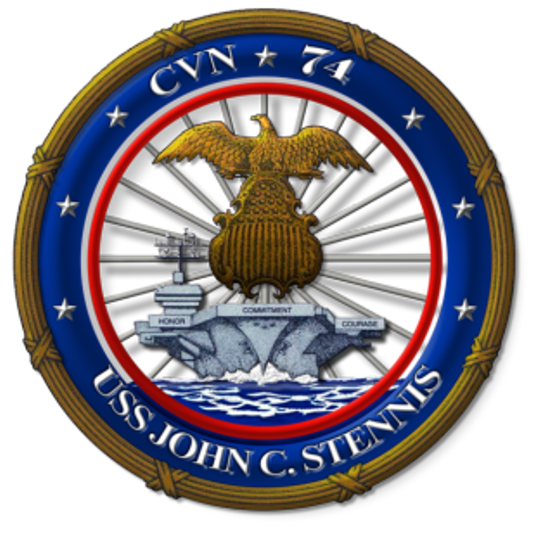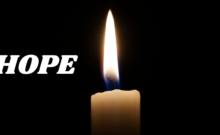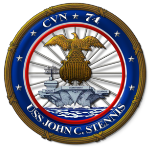 This past week I was fortunate enough to have been invited to embark on the USS John C. Stennis (CVN-74) at sea as part of the Navy’s “Distinguished Visitor” program (30-31 March 2011.) The visit was exhilarating and filled my heart with pride to have had the opportunity to meet the crew of this aircraft carrier. Exhilarating? Absolutely, to see the young men and women of the United States (average age on the Stennis is less than 25) bring the Stennis to life is to understand the power of “We” over “Me.” Pride? Proud to have been amongst those invited to witness first hand the daily routine of the Stennis, to have had the opportunity to sit with both the officers and enlisted personnel and talk about their way of life. To have had the opportunity to listen to the 18-year-old who had been on the ship for 3 months and was having the time of his/her life had to say or to the thoughts of the officer who may have had been in the Navy for 20+ years. My lament, the visit was limited to one over-night, there was so much more to learn about the aircraft carrier and the crew. So let me describe this all too short visit.
This past week I was fortunate enough to have been invited to embark on the USS John C. Stennis (CVN-74) at sea as part of the Navy’s “Distinguished Visitor” program (30-31 March 2011.) The visit was exhilarating and filled my heart with pride to have had the opportunity to meet the crew of this aircraft carrier. Exhilarating? Absolutely, to see the young men and women of the United States (average age on the Stennis is less than 25) bring the Stennis to life is to understand the power of “We” over “Me.” Pride? Proud to have been amongst those invited to witness first hand the daily routine of the Stennis, to have had the opportunity to sit with both the officers and enlisted personnel and talk about their way of life. To have had the opportunity to listen to the 18-year-old who had been on the ship for 3 months and was having the time of his/her life had to say or to the thoughts of the officer who may have had been in the Navy for 20+ years. My lament, the visit was limited to one over-night, there was so much more to learn about the aircraft carrier and the crew. So let me describe this all too short visit.
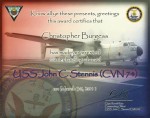 On the morning of 30 March, we assembled at the Navy Air Station, located on North Coronado Island across the harbor from San Diego. We received a command brief, tour of the Navy Aviation headquarters, a visit to the repair and refurbish hangers where helicopters and planes were being serviced. We then were taken to the air terminal to board our transport to the aircraft carrier which was located some 75-100 miles off the coast. Our group of 11 DV’s (our moniker for the next 24-hours) were bumped from our scheduled flight and put on the following. The “flight” was via the C2A Greyhound aka (COD – Carrier On-board Delivery)
On the morning of 30 March, we assembled at the Navy Air Station, located on North Coronado Island across the harbor from San Diego. We received a command brief, tour of the Navy Aviation headquarters, a visit to the repair and refurbish hangers where helicopters and planes were being serviced. We then were taken to the air terminal to board our transport to the aircraft carrier which was located some 75-100 miles off the coast. Our group of 11 DV’s (our moniker for the next 24-hours) were bumped from our scheduled flight and put on the following. The “flight” was via the C2A Greyhound aka (COD – Carrier On-board Delivery) 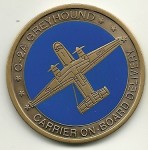 designed specifically to ferry supplies and personnel to the carriers. The twin turbo-prop is handled by a crew of five – two in the cockpit and three in the rear. You sit facing the rear of the plane, harnessed into your seats both with lap and should belts, wear a flotation device and head-gear (called the cranium) w/goggles designed to protect your head from knocks and keep the flying dust out of your eyes and protect your hearing. The flight to the Stennis took about 45 minutes, with the crew signalling to us during the last 15 seconds “here we go” as the plane touched down on the deck and the tail hook grabbed (Trap)
designed specifically to ferry supplies and personnel to the carriers. The twin turbo-prop is handled by a crew of five – two in the cockpit and three in the rear. You sit facing the rear of the plane, harnessed into your seats both with lap and should belts, wear a flotation device and head-gear (called the cranium) w/goggles designed to protect your head from knocks and keep the flying dust out of your eyes and protect your hearing. The flight to the Stennis took about 45 minutes, with the crew signalling to us during the last 15 seconds “here we go” as the plane touched down on the deck and the tail hook grabbed (Trap) 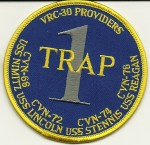 one of the four arresting cables – we went from 160 knots to zero in seconds – your body is literally thrown back into your seat, and it is clear why you are facing backwards. The ramp was lowered and we filed off the plane, to the ready room for our welcome brief and introduction to our hosts from the Public Affairs Office.
one of the four arresting cables – we went from 160 knots to zero in seconds – your body is literally thrown back into your seat, and it is clear why you are facing backwards. The ramp was lowered and we filed off the plane, to the ready room for our welcome brief and introduction to our hosts from the Public Affairs Office.
As our schedule was a little off-skew, we proceeded immediately to the medic station which doubled as the prep room to suit up for our walk out to the flight deck to watch the air operations. We were suited up in vests (with handles in the back designed to allow crew to assist you around should you inadvertently stumble or step out-of-bounds), briefed on the importance not to cross the boundary lines and foul the deck. To say we were excited would be an understatement. We were led to toward the bow and as the door to the catwalk opened to take us out, there was an explosion, alarms and we heard the call, “fire on the flight deck” and the command “fight the fire.” Needless to say, we stayed put in the hallway – an injured crewman was brought past us from the flight deck and personnel passed in the opposite direction heading up to the flight deck to fight the fire. As the situation evolved, we were told to move behind “frame 100” and were escorted towards the stern. We were to learn that an F/A 18 had had a catastrophic engine failure, an explosion occurred causing shrapnel to fly severing a fuel line and creating a fire on the deck. Ten personnel on the flight deck were injured, four seriously, none life threatening (Sailors Injured in USS John C Stennis Flight Deck Mishap). From the visitor’s perspective watching the smoothness in which emergency operations plans were enacted was a testament to the importance of practice and training for the emergency.
Once the fire was out and the situation normalized, which was less than an hour, our tour of the Stennis continued. We learned that passage ways are called “P-ways” that stairs don’t exist – ladders do, some with gradual inclines and others steep. My joints were exercised as we went up and down the ladders multiple times throughout the visit – you see, elevators are for airplanes, munitions and equipment – people walk. And the walking brought us into contact with more and more of the crew, an opportunity to engage, and briefly chat with each. As we traversed the ship, we learned a bit more about the daily life of the crew. For example, each team owns a piece of the ship which they are responsible for keeping clean. The enlisted personnel sleep in an array of triple deck bunks with 79 of their colleagues (80 to a bay – in contrast, we were spoiled – as we were in a stateroom with double bunks), the heads (bathrooms) are located outside the sleeping areas. You will see personnel (including ourselves) walking to and from the showers in their robes and shower shoes.
During our visit, we were taken to the Flight Deck Control, the Captain’s lounge, the Bridge, Weapons, crew mess, ward rooms, introduced to the Navy Cash Card, Air Ops/CATCC, Flag Bridge and our favorite locale – Vultures Row, Arresting Gear Engine Room, the Ship’s Store, Kitchen/Bakery, the Foc’sle, Medical/Dental and the Hanger Deck.
Three areas I would like to highlight are:
- Ordnance on load – we were treated to an at sea on loading of material from dry cargo/ammunition ship USNS Charles Drew (T-AKE 10) to the carrier by zip-lines and helicopter. It was a rapid and elegant dance coordinating the activity between two ships with zip-lines humming and helicopter’s moving back and forth dropping very large containers (Stennis Successfully Completes Ammunition Onload, Offload)
- Chapel/LRC – the briefing provided at the Chapel and the Learning Resource Center was impressive. Not only are religious services conducted in these spaces, the spaces are always open and double as a quite place on an otherwise busy environment for a sailor to come and read, reflect or meditate. Contiguous with the chapel is the ship’s library, some books are purchased and others are donated by Navy support organizations. Also attached to the library is the computer cafe where personnel can get online to check email, post to social network sites and otherwise engage as they may when on shore. Given the proliferation of electronic reading devices, I commended to their attention to the Gutenberg Project where 33,000+ ebooks are available for free and electronic download – a great resource at a great price. Interestingly, at each port of call, the religious program team organizes on-shore excursions to interact and give back to the communities being visited – sometimes it is painting a local school,others it may be to visit a hospital, or teach english for a day – what a great way to learn of other cultures, while projecting what is good about the United States – its people.
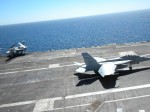 Flight operations – as can be expected the flight operations were interrupted due to the need to thoroughly review the incident which had occurred on the 30th and then ensure the flight deck was clear of debris. Once this was accomplished, the flight operations commenced about 30 minutes prior to our departure from the Stennis. There is truly nothing like standing on bow side of Vultures Row in the direct jet-wash of an F/A 18 – the heat is tremendous, the power shakes you and pushes you backwards and the roar of the engines at the moment of catapult is thunder amplified. On the other side of the tower the landings were occurring. The planes come down and catch the arresting cable laid and jolt (big time) to a stop.
Flight operations – as can be expected the flight operations were interrupted due to the need to thoroughly review the incident which had occurred on the 30th and then ensure the flight deck was clear of debris. Once this was accomplished, the flight operations commenced about 30 minutes prior to our departure from the Stennis. There is truly nothing like standing on bow side of Vultures Row in the direct jet-wash of an F/A 18 – the heat is tremendous, the power shakes you and pushes you backwards and the roar of the engines at the moment of catapult is thunder amplified. On the other side of the tower the landings were occurring. The planes come down and catch the arresting cable laid and jolt (big time) to a stop.
Our visit ended with our boarding the C2A Greyhound for our trip back to the Naval Air Station. We boarded, strapped in and taxi’d over to the launch catapult. The crew gave us the signal and then “voooom” we were launched from zero to 170 knots within mere seconds – the ultimate thrill ride – the feeling was what I had imagined being shot out of a cannon would feel like. Definitely a high-point of the visit.
In sum, the Navy requires our collective support, be we civilian or government. Without our support they are going to be resource depleted not only with respect to personnel and equipment but also with respect to the morale and welfare of the men and women who voluntarily put themselves in harms way. If you are young man or woman looking to make a difference and are interested in joining the NAVY – here’s the link – Go Navy! If you are interested in supporting the Navy from your hometown, look into the Navy League.
I offer my sincere thanks and appreciation to Captain Reis for allowing us to visit the USS John C. Stennis a most remarkable vessel. I would also like to call out the team within the Stennis’ Public Affairs Office for the many kindnesses afforded to our group of DV’s. To the men and women of the Stennis, thank you for making our visit such a success – well done! Most importantly to all who serve in our armed forces be it the Navy or any other branch, thank you for your service,
PS: I thoroughly enjoyed hearing John Fogerty’s “Centerfield” being piped throughout the Stennis as the ship separated from the Drew – rock and roll at sea – it makes perfect sense to me.
——————————————–
Stennis Links:

